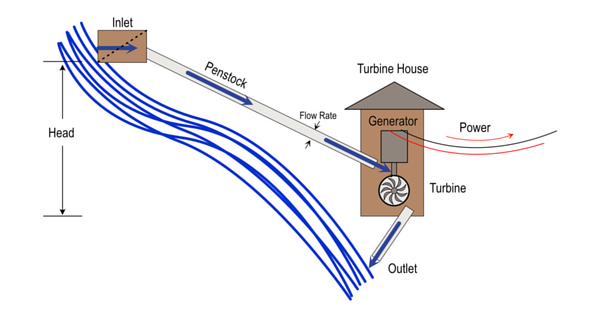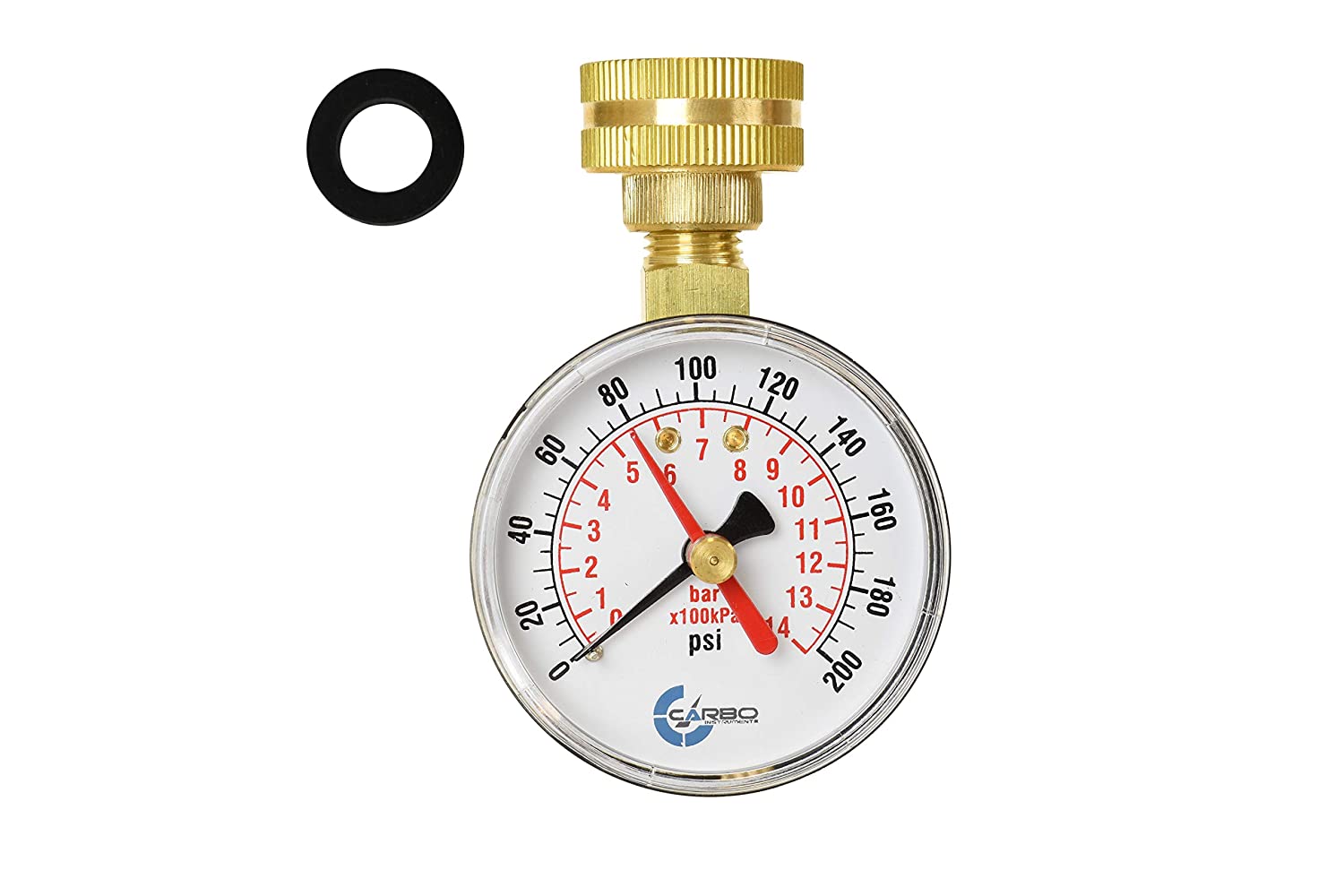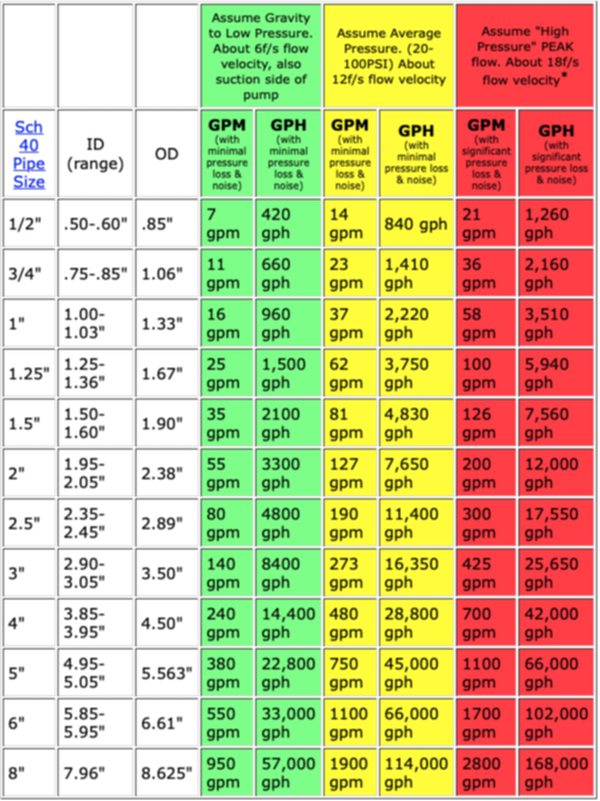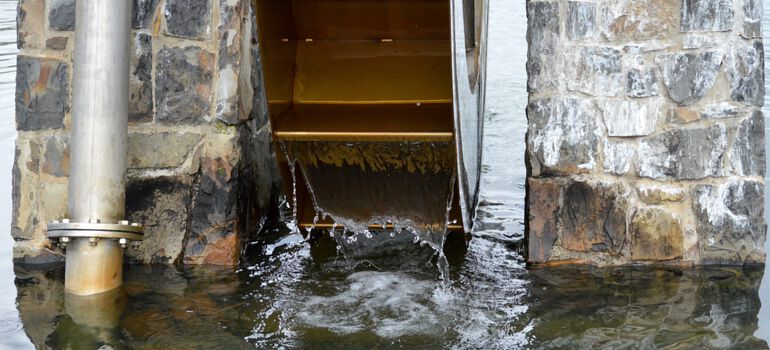While building up my own off grid homestead, I wondered if off grid micro-hydro might be a good match for my needs. With more consistent power generation and less visibility, micro hydro can be a good power source. Let me share what I’ve found with you.
How to step up free water (micro-hydro) power. Choosing a proper site is most important at the start. Construction of water inlets, penstock, turbine house, and outlet is the next big step. Finally, proper selection of generator, turbines, and electrical connections complete the process of micro-hydro installation.
Each of these steps can be a process in itself, and proper planning is key to a productive and functional micro-hydro system. Whether off-grid or as part of a supplemental power system, follow along while I cover the basics of setting up your own water based power generation system.
Setting Up a DIY Micro-hydro Power Plant
These are the steps that I take to set up your own micro-hydro:
- Determine inlet and outlet placement, and maximum potential power generation
- Construct water flow components: inlet, filter, pensock, turbine house, and outlet
- Choose an install a suitable turbine and generator combination
- Wire power system and controlling electronics
Recommended book: Microhydro: Clean Power from Water
How to Choose the Placement of Your Micro-hydro Power System
With water power, unlike solar, you can’t just add more generators and turbines to get more power, because you only have so much water flowing at a time. If your stream has less than 5 ft drop when using batteries or 75 ft drop when producing direct AC, then your site probably not have to potential to produce useful energy.
With micro-hydro, placement of the inlet/outlet is critical to getting maximum energy output. Like most renewable energy sources, hydro power capacity depends on the whims of mother nature. The amount of altitude decrease from where the driving water enters the system (inlet) to where it drives the turbine (turbine house / outlet) determines the pressure or “head” of the system. Head determines what pumps / generators would be suitable for your system. And, combined with the flow rate (gallons per minute) constrain the maximum power you could get out of the site.
Placing your inlet and outlet so they have as much drop a possible adds extra power to your system, but may increase the cost of the penstock piping and support structures, if any. On the other hand, if you have plenty of water to spare, larger piping that runs shorter distance could potentially produce the same power for less cost.

What is a Penstock?
Penstock is the technical term for the piping the runs between the inlet and the turbine of your micro-hydro system. This can be any commonly available piping, but if you plan to use plastic pipes be sure it is rated for external use or it is well covered, as many plastics degrade in sunlight.
It is vital that any penstock system be rated to handle the weight and pressure of the water it carries. Penstocks, unlike water wheel sluices, must maintain water pressure and be free of leaks where water can escape or air can enter. Loss of pressure at this point could significantly reduce the power output of your hydropower plant.
How Much Water Power Can My Property Produce?
The amount of energy that your property can support depends on two things:
- How much drop you have (pressure / head)
- How much water flows through your property
In order to calculate how much power you could feasibly produce, you need to determine the head (or pressure) you have available and measure the flow rate of your stream. When you have these numbers the available power can be calculated easily by multiplying the pressure by the flow rate.
Tip: Google search has a built in calculator that does unit conversion, which makes the calculations very easy. To calculate your hydro power production capacity, type something like the following in to Google search:
100 gallons/minute * 30 psi in wattsThis will return the power you could get from a 100 gallon/minute stream with 30 psi of static pressure. Substitute your measured values.
Be aware that the value calculated is an absolute maximum. You will probably get between 50% – 80% of this value in the final installed system.
How to Measure Available Head or Pressure of a Micro-Hydro System
The simplest way to measure pressure is to use a garden hose and a pressure guage, which can be as little as $10 online. It connects directly to standard garden hoses, which are easy to buy or borrow if you don’t already have a few on hand. Using this gauge takes a lot of the guess work out of calculating the power that can be generated from your off grid water power generation system.

How to measure pressure with a gauge and hose
- Take your hose and gauge to the potential inlet site
- Submerge the hose, making sure all the air gets out of the line
- Screw on the pressure gauge
- Extend the gauge down to the potential site of the turbine, keeping the open end of the hose submerged in the water
- Read the number from the pressure gauge
Head based measurement
If your drop is quite long, it may be easier to use measure the drop directly. All you need to know to calculate pressure is the straight up and down distance between you inlet and turbine. Depending on the situation this can be measured with a tape measure (for cliffs / waterfalls), laser levels (for steeper inclines), or with an accurate GPS or topological maps (for very high heads).
It’s very important to note that the head is not the distance between the inlet and turbine directly but the direct up and down change in height or altitude. Making this mistake could be quite costly at this point.
To calculate the pressure from the drop that you measured, multiply the distance in feet by 0.434 to get the pressure in PSI. (Multiply meters by 9.8 to get pressure in Kpa).
Measuring Flow Rate of A Micro Hydro System
If you have a fairly small stream, and a waterfall or culvert in place, then the easiest way to measure the flow rate is using the bucket method. This method is the same as used by well drillers, and simply requires a couple of 5-gallon buckets and a watch or timer.
Bucket method for measuring flow rate
- Set your watch / timer for one minute
- Start the timer and collect all flowing water in the bucket
- If the bucket fills up, switch it out with an empty one and dump out th water
- Keep count of the number of buckets filled up until the timer goes off
- The number of buckets times 5 is the gallons per minute. (Include half or quarter buckets in the calculation)
Be aware that if you are using all or most of the water available in a small stream for power generation, that many streams have flow rates that vary throughout the year based on rainfall and snow melt. So, it’s best to test the flow rate several times thought the year to determine what the lowest flow rate could be and use that in your calculations.
Weir system
For larger streams, the bucket method will not be possible, and the best method available for flow rate calculation is the weir method. This involves building a low dam (weir) with a flat top over which the water can flow. A 2x4 serves as a decent weir top, only which requires a bit of digging and filling in to get all the water to flow over top of it.
To calculate the flow rate, measure the width of the weir and how deep the water is flowing over the top (also called head, but not the same as head measured above). Take your measurements in feet and plug them in to the following tables to get the flow rate in cubic feet per second, which can be plugged in to Google’s calculator to calculate energy potential as above:
Construction of Micro-Hydro Inlet
Building the system of pipes or weirs that takes water from the river or stream, out to your generator and then back can frequently be the most time consuming and expensive part of building a micro-hydro system.
The inlet can be as simple as a wooden box with a screen to prevent debris and silt from flowing in to your turbine, which could clog or damage the expensive blades and injectors. Inlet screens work best when they are perpendicular (90 degrees) to the flow of water, so that the natural flow of the stream will help keep the screen clear.
Poorly designed inlets can be a major source of maintenance and malfunction with your off grid power system, so make sure to take the time to ensure it works properly before moving on to the next steps.
Building a Micro-Hydro Penstock
The penstock is usually a long pipe the runs from the inlet to the turbine or power house. Running a PVC pipe of the correct diameter is usually the cheapest and most straight foreword way to go for homestead scale DIY water power installations.
While some low-head micro-hydro systems employ an open canal or sluice directly from the river to turbine structure, these systems generally require large water flow rates in order to function well enough to be worth the cost. However, if you do have access to a large river to run your turbine, check out the linked document, as there are many exciting advances in turbines which could make such a project fairly robust and profitable.
For the rest of us, the first question we are going to ask is, “how big of a pipe do I need?” The answer depends on your expected flow rate. Check out this PVC pipe sizing chart, which is the first chart on the page which lists pipe diameter to flow rate based on the expected pressure.
According to this chart, for instance, 6" diameter pipe could handle 550 gallons per minute at less than 20 PSI and 1100 gallons per minute at up to 100 PSI. For reference, this 6" pipe at 100 PSI would produce at maximum 4.7 killowatts of power, which is more than enough to run a small household or farmstead even after inevitable inefficiencies and power loss along the way.
Over sizing your pipe is not an issue, and while it may result in extra expense it will not reduce the function of your power generator. Indeed, it also gives you extra capacity to grow in to in the future, and considering how time consuming and expensive penstock installation can be, might be a wise decision if there is any possibly you might want to grow you system capacity in the future.

Above Ground vs Buried Penstock
When building a penstock, you have the option of leaving the pipe above ground or burying it underground. Both of which have their advantages and disadvantages.
Burying your penstock is usually much more work than leaving it on the ground or above ground. It also makes any maintenance work, like fixing a burst pipe, much more difficult. But, putting it below ground does a lot to protect your pipe from accidental damage such as a tree fall, as well as projects your PVC from UV damage caused by the Sun that can cause for pipe to become brittle and break over time.
Lastly, if while running water will not freeze, if you live in a freezing climate you must design your hydro-power system so that water flow can never stop. Even an accidental plugging up of the inlet or emergency shutdown could cause your pipes to freeze and burst, leaving a costly repair on your hands.
On the other hand, above ground pipes can be very easy to install, but it still takes some work to build a lasting system. Just placing pipes on the rough ground may not be enough. Some digging or building of support structures to keep the pipes straight and well supported along the whole length is recommended for a permanent power installation.
Also, be aware that many PVC pipes are not rated for exterior use and should be protected from the Sun by a coat of acrylic or latex paint. Oil paint is not recommended.
The Micro-Hydro Turbine House
Building the turbine house and outlet need not be a big production. Any simple structure will work including a shed or pallet wood construction. Reclaimed or recycled material work great here. This building need not be heated, unless you plan on stopping the turbine with water in it during freezing temperatures. If your water power generation kit or system has an emergency stop feature, you may want some source of emergency heat as well, so the turbine won’t freeze up and crack in case of an unforeseen winter stoppage.
Usually one builds the turbine house near to the stream or river, so that you can use a short length of pipe or ditch to bring the spent water right back to the water way. You also have the option, if you jurisdiction allows you to keep the water for other uses, to let the discharge flow directly to irrigation ditches or to a cistern for drinking or other household uses.
Choosing the Right Turbine for Your Off Grid Hydro Power System
There ar many commercial small scale hydro power turbines on the market. They are generally rated for a maximum power generation and have a manufacturer recommended range for head (pressure) and flow rate. Use the information you gathered above to size the correct commercial turbine for your situation. Note that sometimes two or three smaller turbines / generators might be the best option considering price, and gives you a nice level of redundancy, so that if one turbine has a malfunction you still have one or two more in reserve so that you will have some power available while you fix the problem, albeit a bit less than normal.
If you want to try your hand at creating your own turbine, check out this DIY turbine resource. Getting something to work well at reasonable efficiency is not necessarily easy, so I recommend that if you intend to use water power as your primary energy, you might be better off going with a commercial model.
One low cost DIY turbine option is to use the blades from a similarly sized centrifugal pump, who’s design is similar to a Francis turbine.
| Turbine Type | Flow / Head |
|---|---|
| Pelton | Low flow / High head |
| Turgo | Moderate flow / Moderate head |
| Cross-flow | High flow / Low head |
| Francis | varies by design |
| Kaplan | varies by design |
Choosing the Right Generator (or Alternator) for Your Off Grid Hydro Power System
Generators, also sometimes called alternators, are rated by their maximum size, intended voltage, and power output type (AC vs DC).
Choose a generator that is rated for at least as much power as your system is designed to generate. So a 1 kW system needs to have at least 1 kW generator, although larger generators can be employed safely with little loss of efficiency.
DC Power Systems
The electrical characteristics of the generator depend on the design of the electrical system you are connecting to. For an off grid system, especially if you are combining hydro-power with solar or wind power, you will need to convert your generator’s output to DC in order to charge the battery bank, since all battery are inherently DC devices. For my money, it makes the most sense to choose the highest DC voltage supported by your charge controller as the output of your water generator.
This could be between 24 and 72 volts DC.
AC Power Systems
If you plan on running only water power, with no battery backup or batteries only for emergency situations, then you have the option of running directly on the AC power generated. This means you would choose a 120 volt AC generator (in the United States) or 240 volt AC (in most other places).
The upside to using AC in this case is greater simplicity and efficiency on the electrical side. This works great if you plan on only using lights or simple restive loads on your systems. However, if you plan to use any electronics, motors, and other appliances on such a system, then you will need to be certain that your generator turns at exactly 60 hertz (turns per second) otherwise you run the risk of damaging your equipment. This generally accomplished with some active electric control of the water flow which response to changes in demand and keeps the generator during at a constant rate.
Why I Recommend DC Hydro-Power Systems
In my mind this added complexity is generally not worth the risk, and I rather go with a simple DC system using standard charge controllers and inverters which are readily available for solar systems. Going this route means all the complexity is handled by the electronics of the inverter and charge controller. Likewise, you can easily add additional water generators, wind generators, or solar arrays by simply adding controllers without worrying a about phase matching or other such complexities of AC only systems.
However, be sure that your charge controller has the option to attache a dump load, since it is unsafe for a spinning turbine to be completely disconnected from a load when the batteries are at full charge. Higher end charge controllers allow you to connect a secondary load that will only be activated when the batteries are full, and allow you to dump extra energy in to secondary tasks such as heating a green house.
Can I Use Hydro-Power for a Grid Connected System?
In order to use a micro-hydro system with a grid-connected home you will need to install a grid-tie inverter, which allows your generator to work in concert with the power coming in to your home. In some states you will be able to sell any excess power back to the grid.
Consult with your power company and local renewable energy installers to see what would be possible in your area. For a grid-tie system, you will certainly need permission from the utility company and require a commercial system installed by a professional.
Related Questions
Can a water turbine power a house?
Yes, with access to a sufficiently powerful flow of water, low cost micro-hydro systems are sufficient to power a family home, homestead, or farmstead. Check with local authorities to determine if you can legally install a hydro-power station on your property
What is the most efficient water turbine?
The efficiency of water turbines depends on the pressure (head) of your water source as well as the flow rate. Pelton turbines are best for high head situations while Francis turbines work well for low head conditions.
How much does a micro hydro system cost
While the price varies quite a bit depending on the details of the location linked to construction costs, micro-hydro power generally costs in the range of $1,300 kW – $8,000 kW.


